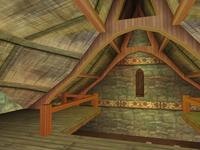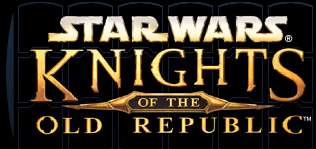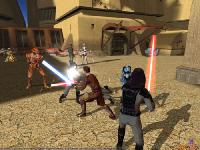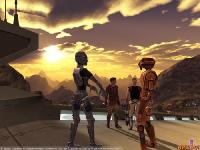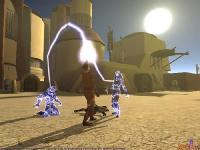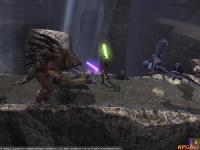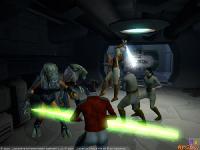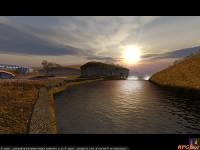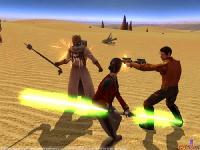|
|
|
Main News Forums Games Games Database Top 100 Release List Support Files Features Reviews Previews Interviews Editorials Diaries Misc Download Gallery Music Screenshots Videos Miscellaneous Staff Members Privacy Statement |
Star Wars: Knights of the Old Republic (PC) - Review
There's hardly a bigger brand name than "Star Wars" but for every successful Star Wars licensed game there has been a dismal failure. Oddly, this rich milieu has never been used for a single-player RPG - enter Bioware, undoubtedly one of the most commercially successful RPG developers in recent years with 'Star Wars: Knights of the Old Republic'. Available for both the Xbox and PC, it was released first on the Xbox to huge success. So you want to be a Jedi…
Have Spacecraft, Will Travel Undoubtedly players will have certain expectations of a Star Wars RPG - a certain look and feel, familiar places and races and in the main KotOR successfully delivers this with a strong and consistent Star Wars atmosphere. Players will travel to a wide variety of exotic planets with different environments such as the heavily forested Wookie planet of Kashyyyk and the harsh desert world of Tatooine. There's a good blend of new sights to maintain interest with enough familiar places to create a strong Star Wars feel.
The moral of the story One advantage to streamlined, quest-related locations is good pacing - you won't ever go far in KotOR without coming across new NPCs with their quests. Like many RPGs, quests in KotOR often boil down to fedex or kill-the-foozle missions but Bioware's designers have done a good job of making them interesting, often through NPCs who have detailed backgrounds and situations with a twist that gives them a little spark. Over the course of the game you'll have the opportunity to solve a murder, resolve cultural problems, cure a disease epidemic and save a man from a trap set by his abused wife. A moral dimension can be found in many of KotOR's quests. This might be a simple matter of choosing between a path that yields immediate profit versus helping an NPC for no obvious gain but sometimes the dilemma is more striking. This in turn is part of the larger Good vs. Evil theme that runs through the game as a major part of the story and also the core of the roleplaying experience that KotOR offers. Many RPGs have an alignment system but relatively few have a fully developed path for evil characters. KotOR fully supports evil characters and Light- or Dark-side Points are accumulated based on the player's decisions at key points in the plot. These points affect the cost of using Light or Dark Force abilities when the player is a Jedi. An animated status screen shows the movement of the player's alignment with the background changing from light blue for good to an ominous red cloud for evil.
KotOR's plot is a simple item hunt at heart but it's told in an effective fashion and set against a grand backdrop of galactic struggle between the Jedi and the Sith. Bioware has done a good job of finding the spirit that made Star Wars Episode 4 such a success. After the initial couple of planets, KotOR allows you to travel to most of the remaining locations in any order. This provides a welcome degree of freedom, although it soon becomes apparent that each planet is structured in the same way and any appearance of non-linearity is really illusory. In each case you'll need to resolve some local crisis or remove a barrier before you are able to access the final goal on that planet and the sequence becomes a little predictable.
Interacting with puzzles
Another departure from western CRPGs is the inclusion of mini-games. There are three of these in KotOR: Swoop Racing, Ebon Hawk Gunner Station and Pazaak. Pazaak (a card game) and Swoop Racing can be used to win extra money at various points and I found them quite fun, although the presentation of these games isn't up to the same standard as the rest of KotOR. On several occasions a mini-game needs to be completed to advance, which some players may find frustrating and doesn't seem appropriate for a CRPG. Apart from puzzles and some computer terminals the degree of interaction with the environment in KotOR is disappointing. Players can open some barrels and lockers but most objects can't be moved or used. There is a basic crafting ability that can be used to improve some armour and weapons but this is generally underdeveloped apart from its use with lightsabres. Interacting with characters If exploration is a weak link in KotOR gameplay, its strength is character interaction, particularly within the party. Up to nine characters can be recruited to join you on your travels, with two accompanying the PC in the current adventuring party. Most of these characters have well-developed backgrounds and personalities and your interaction with them is a major part of the game. Over the course of the game they'll tell you about their pasts, they'll pass comments and even talk to each other, sometimes with funny results.
The background of many of the party-members is directly relevant to the gameplay with quests to resolve problems for them and even pivotal plot points revolving around them. In general, this is a good thing and many players will come to genuinely care about certain party members, however, it can feel contrived. At key points you'll be forced to include particular party-members in the current adventuring party. While this has the benefit of making each character relevant it's a pain when you just don't like that character. It's even worse when the game interrupts you (usually at the worst time) with the message that one of them "looks like they have something important to say". Combat As in most RPGs, combat will play a prominent role in your journey across the galaxy. KotOR uses a realtime-with-pause system with underlying continuous rounds, much like all of BioWare's previous RPGs. In fact, superficially the combat is very similar to NeverWinter Nights but there are a number of key differences that make it quite a different experience. By default, the game pauses when an enemy is sighted or the player is attacked. Selecting a party member and clicking on an enemy will use the default attack, or you can select one of the available feats, powers or a thrown weapon like a grenade. Up to four actions can be queued for each party member and the spacebar releases the action. The animation for combat actions is simply fantastic, with participants attacking and dodging, huge leaps through the air and spectacular lightsabre swordplay.
Positioning your party members for best effect is frustrating and usually not worth the bother. Since movement in KoTOR is based on the Xbox controller system, there's no point-and-click movement. To move a character to a better position (moving a ranged character behind melee fighters, for example) you'll need to take control of them and manually move to the new position, which also clears their combat queue. All up, most of the time you'll queue some actions and leave the movement to the AI. There is also a clear disparity between ranged and melee weapons. Early in the game it's pretty easy to find fairly reasonable swords that easily outclass the blasters that are available at the time and enemies wearing energy shields will further limit the effectiveness of blasters. When the player becomes a Jedi, lightsabres are very powerful and have defensive capabilities making them the obvious weapon of choice and wasting any ranged feats the player invested in. While I'm not an expert on Star Wars lore, the emphasis on melee weapons seemed out of place. Becoming a Jedi adds Force Powers into the mix, which makes combat much more interesting. I found the Dark powers particularly fun and a treat to watch but similar limitations apply: with only 3 active Force Powers at any time, you'll often find yourself queuing the same actions repeatedly. Again, balance is an issue - take "Force Wave" and you'll mow through whole armies. Control
The main on-screen user interface is an excellent design, with appropriate information clearly displayed while leaving the view area almost totally un-obscured. A small mini-map is in the top-left corner, small menu icons in the top-right and character portraits in the lower-left. My only complaint is the lack of an on-screen status area during combat to display die-rolls - after playing The Temple of Elemental Evil, it's hard to play another RPG without that excellent onscreen hyperlinked roll history. Unfortunately, the other interface elements are not as good. For starters, there are separate menu screens for Character Info, Character Equipment and Party Inventory, which could have been combined with a different design. Each of these screens is a relatively small window that wastes the available screen space. The Party Inventory is particularly frustrating with every item listed in one vertical column, which requires a lot of scrolling to work through. Since items like Datapads are not automatically removed after they've been used, it's pretty easy for this list to grow to an unmanageable size and require lengthy searches to find required items. There are some filter buttons that help but clearly these interface elements were designed for ease of use on the Xbox without a mouse. Likewise, rather than a traditional drag-and-drop paper doll for character equipment, KotOR requires you to click on an equipment location (such as the left or right weapon slot) and scroll through a list of suitable equipment. In general, the party control system is well implemented and unobtrusive. You can easily switch characters by clicking on their portrait, with the other party-members under AI control. There are occasional pathing problems with one character blocking another and similar issues but nothing as frustrating as the endemic pathing issues in the Infinity Engine games. Technical Stuff
Characters are a little blocky but the faces are well done and capable of some expression although the same faces are used a little too often. Some of the alien species look great with nice effects to realise their skin textures. Clothing textures are sometimes awful although texture problems exist in various places - the low-resolution backdrops in the distance are often a distraction, for example.
Many players will remember KotOR in the future for the quality of the voice acting. KotOR features fully voiced dialogue and it's simply the best quality voice acting I've encountered. The emotion, timing and contextual understanding in the voice acting is outstanding. Even the alien dialects are voiced and although it soon becomes apparent it's gibberish, it sounds good (although they run too long). While the sound effects are not especially memorable they are authentic, from the beeps and pops of droids to the unmistakeable sound of lightsabres clashing. Jeremy Soule provides the music with an occasional refrain from John Williams' classic soundtrack. Soule's work in KotOR is not as good as his award-winning form in Icewind Dale but it's quite enjoyable. Time to wrap up
In many ways, KotOR is really an adventure game more than a CRPG - you'll spend more time solving puzzles than "roleplaying". It's clear to me that BioWare intended KotOR to appeal to a broad audience, choosing to reduce the number of character options, simplifying combat and offering the appearance of non-linearity but without the true substance. My first run through took nearly 60 hours and around 40 hours for the second -- most of which I really enjoyed -- but I have no burning desire to play it again, at least not for now. A great RPG keeps me awake at night: I ponder which path to take and how to develop my character and I can't wait to get back to it. KotOR just couldn't quite reach that level for me. Capturing an authentic Star Wars atmosphere and filled with slick production values including memorable voice acting, KotOR is a fun adventure with involving characters that will appeal to most gamers. It's a pity the interface was clearly designed for the Xbox and the underwhelming combat and limited roleplay elements will leave some seasoned RPG players feeling just a little let down.
Rate this title and view comments Game Info Printer Friendly Version |
||||||||||||||||||||||||||||||||||||||||||||||||
|
All original content of this site is copyrighted by RPGWatch. Copying or reproducing of any part of this site is strictly prohibited. Taking anything from this site without authorisation will be considered stealing and we'll be forced to visit you and jump on your legs until you give it back. |
||




